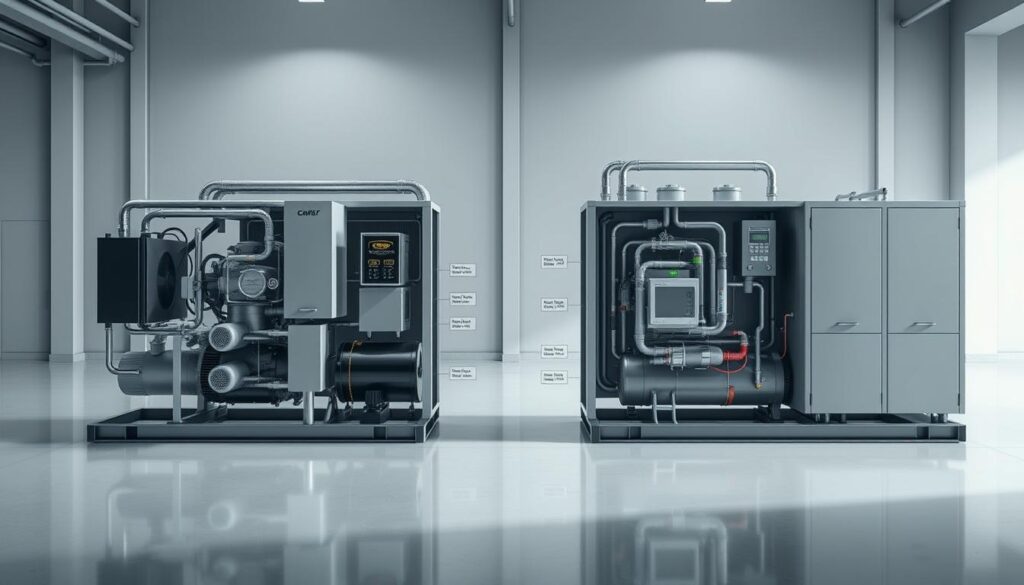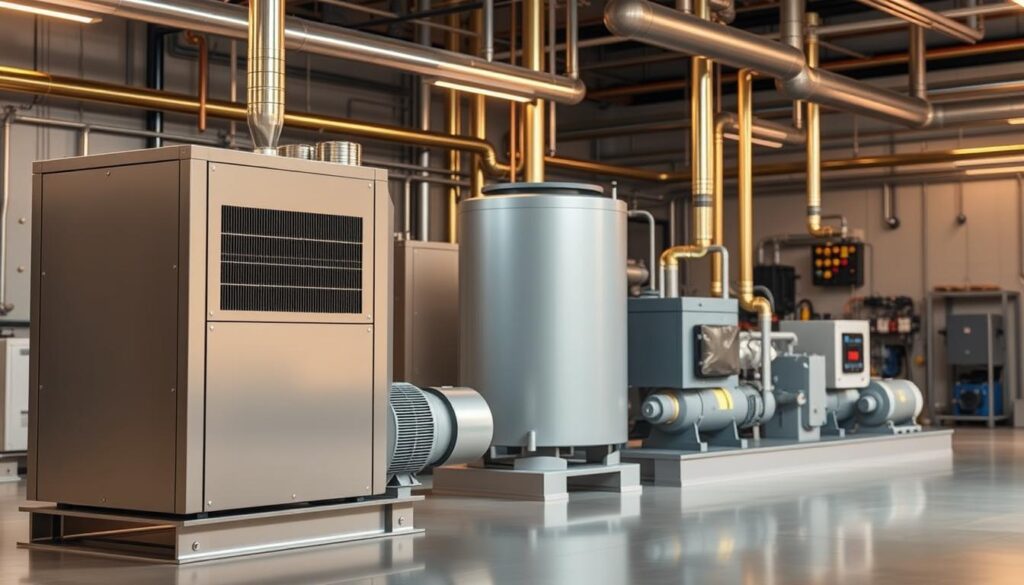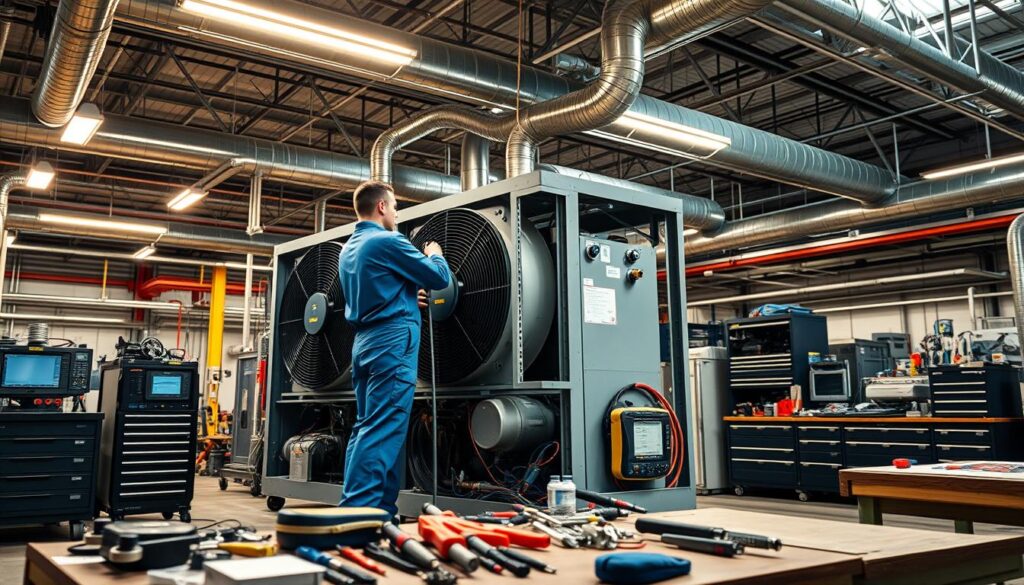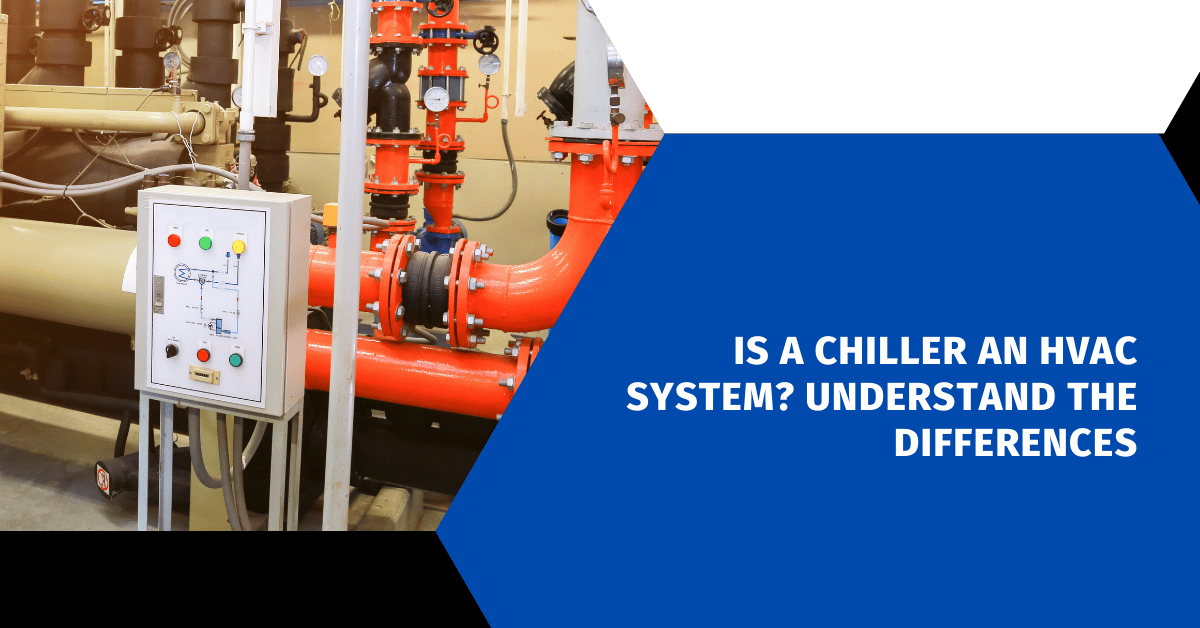Affiliate Disclosure
HVAC Guide Guys is a participant in the Amazon Services LLC Associates Program, an affiliate advertising program designed to provide a means for sites to earn advertising fees by advertising and linking to Amazon.
Is a Chiller an HVAC System? Ever thought about what makes a chiller different from regular air conditioning? Many people, like building managers and engineers, mix up these terms. But the truth is, HVAC systems and chillers are not the same.

Chillers are more than just air conditioning. They are key for keeping big commercial and industrial places cool. Knowing how chillers work can help you choose the best way to control your building’s climate.
Exploring HVAC systems and chillers will show you how they differ. This is important for anyone who manages buildings, works on engineering, or just wants to learn about cooling systems. You’ll discover how these technologies are designed, work, and are used in different ways.
Key Takeaways
- Chillers are specialized cooling systems distinct from traditional HVAC equipment
- Large commercial buildings often rely on chillers for advanced temperature management
- Understanding the difference between HVAC systems and chillers is key for good climate control
- Chillers offer more powerful and complex cooling solutions
- Technical complexity separates chillers from standard air conditioning units
Table of Contents
Understanding the Basics of HVAC Systems and Chillers
Exploring cooling systems can seem overwhelming. Yet, knowing the basics is key to keeping spaces comfy. Today’s buildings use advanced climate control, not just air conditioning.
What is an HVAC System?
An HVAC system manages air quality, temperature, and humidity indoors. It combines heating, ventilation, and air conditioning. This mix ensures spaces are comfortable for living and working. The cooling part is vital for keeping temperatures right.
- Regulates indoor temperature
- Controls humidity levels
- Ensures air quality and circulation
- Provides year-round climate comfort
Role of Chillers in Building Climate Control
Chillers are key in cooling systems, removing heat from liquids. They’re vital in big buildings where keeping temperatures just right is important.
| Chiller Type | Primary Application | Cooling Capacity |
|---|---|---|
| Water-Cooled Chillers | Large Commercial Buildings | 500-5000 Tons |
| Air-Cooled Chillers | Medium-Sized Facilities | 50-500 Tons |
| Absorption Chillers | Industrial Processes | 100-2000 Tons |
Key Differences Between Traditional HVAC and Chillers
Traditional air handlers deal with air flow, while chillers focus on cooling liquids. An air handler moves conditioned air. A chiller cools the liquid, which then lowers the room temperature.
Chillers offer a precise cooling method for complex spaces.
Explore Our HVAC Shop
Looking for top-rated HVAC tools, parts, and accessories? Visit our shop and find the perfect solution for your needs.
Visit the ShopIs a Chiller an HVAC System: Exploring the Connection
Exploring the link between chillers and HVAC systems is key. Chillers are not standalone HVAC systems but key parts of bigger climate control setups. They are vital for managing temperature and humidity in commercial and industrial areas.
Chillers are essential parts of HVAC systems, mainly in big buildings. They cool by removing heat from liquid through vapor-compression or absorption refrigeration. This makes cooling efficient over large areas.
- Chillers extract heat from water or other fluids
- They support complex HVAC system cooling requirements
- Essential for maintaining consistent temperature control
Whether a chiller is an HVAC system depends on the context. It’s not a full HVAC system alone but a key subsystem for climate control. Places like industrial facilities, hospitals, data centers, and big commercial buildings use these advanced cooling systems.
| Chiller Type | HVAC System Integration | Primary Function |
|---|---|---|
| Water-Cooled Chillers | High Integration | Centralized Cooling |
| Air-Cooled Chillers | Moderate Integration | Localized Cooling |
Understanding the connection between chillers and HVAC systems shows their teamwork in making environments comfortable and controlled. These cooling technologies keep getting better, providing more efficient climate solutions.
Types of Chillers in Commercial Buildings
Choosing the right cooling system for your commercial building is key. You need to know the different types of chillers. Each has its own benefits and meets specific cooling needs in various settings.
Chiller systems are vital for keeping large commercial spaces cool and comfortable. There are three main types: air-cooled, water-cooled, and absorption chillers.
Air-Cooled Chillers
Air-cooled chillers are great for smaller spaces. They use the air around them to cool down. They’re perfect for places with little water or for smaller buildings.
- Best for buildings under 150,000 square feet
- Lower initial installation costs
- Easier maintenance requirements
- Suitable for moderate cooling loads
Water-Cooled Chillers
Water-cooled chillers are the most efficient for big buildings. They use water from cooling towers to cool down. This makes them ideal for high-demand areas.
| Feature | Water-Cooled Chillers | Air-Cooled Chillers |
|---|---|---|
| Efficiency | High (up to 70% more) | Moderate |
| Installation Cost | Higher | Lower |
| Maintenance | Complex | Simpler |
Absorption Chillers
Absorption chillers use heat to cool. They’re great for places with waste heat or renewable energy. This makes them eco-friendly and energy-efficient.
- Utilize thermal energy for cooling
- Environmentally friendly operation
- Lower electrical consumption
- Ideal for industrial and large commercial applications
Choosing the right chiller depends on your building’s needs, budget, and environmental goals.
Explore Our HVAC Shop
Looking for top-rated HVAC tools, parts, and accessories? Visit our shop and find the perfect solution for your needs.
Visit the ShopEssential Components of a Chiller System
Knowing the key parts of a chiller system is vital. These machines cool spaces by removing heat. They have four main parts that work together to keep temperatures just right.

The compressor is at the heart of a chiller system. It’s key to the cooling process. It pushes refrigerant through the system, making it possible to cool things down.
- Compressor: Drives refrigerant circulation and increases its pressure
- Evaporator: Absorbs heat from the building’s water or air
- Condenser: Releases captured heat to the external environment
- Expansion Valve: Regulates refrigerant flow and pressure
The evaporator is a heat exchanger. It’s where refrigerant takes in heat from water or air. As it goes through the evaporator, it turns from liquid to gas, pulling heat out of the system.
| Component | Primary Function | Key Characteristic |
|---|---|---|
| Compressor | Refrigerant Circulation | Increases Refrigerant Pressure |
| Evaporator | Heat Absorption | Converts Liquid to Gas |
| Condenser | Heat Rejection | Releases Thermal Energy |
| Expansion Valve | Refrigerant Control | Manages Pressure and Flow |
Each part of the chiller system works together for efficient cooling. The heat exchanger helps transfer heat between different things. This lets the system control temperatures well in big buildings.
How Chillers Work: The Cooling Process
Chillers have a complex cooling system that’s really interesting. They keep your building cool by removing heat. This makes sure the temperature is just right.
Chillers use a special cycle to cool down your space. This cycle changes heat from inside to outside. It has many steps that work together to keep you comfortable.
Refrigeration Cycle Explained
The refrigeration cycle is a closed loop with four main parts:
- Evaporator: Takes heat from the building’s water
- Compressor: Makes the refrigerant hotter and more pressurized
- Condenser: Sends the heat outside
- Expansion Valve: Lowers the refrigerant’s pressure and temperature
Heat Transfer Mechanism
A heat exchanger is key in moving heat. Warm water goes into the evaporator. The refrigerant takes its heat, cooling the water. Then, the water goes back to the building.
| Component | Function | Temperature Change |
|---|---|---|
| Evaporator | Absorb Indoor Heat | Decreases |
| Compressor | Increase Refrigerant Pressure | Increases |
| Condenser | Release External Heat | Decreases |
| Expansion Valve | Reduce Refrigerant Pressure | Drops Significantly |
Water Distribution System
The water system is key for cooling. It sends chilled water through pipes. This keeps temperatures steady in different areas, giving you control over the climate.
Benefits of Using Chillers in Large Buildings
Chillers are key for cooling big commercial and industrial areas. They help keep your building comfy and save energy. Chillers are better than old air conditioning ways.
Big buildings need smart cooling. Chillers control temperature well, handling big cooling needs. They keep temperatures steady over many floors and areas.
- Precise temperature regulation
- Enhanced energy efficiency
- Scalable cooling capacity
- Reduced long-term operational costs
Getting a chiller might cost a lot at first. But, it saves a lot of energy over time. This can cut cooling costs by a lot.
| Chiller System Benefit | Performance Impact |
|---|---|
| Energy Efficiency | 20-40% reduction in cooling costs |
| Temperature Control | Within 1-2 degrees of set point |
| Operational Lifespan | 15-20 years with proper maintenance |
Choosing the right chiller changes how your building manages the environment. Getting a pro to check your cooling needs is key to getting the most benefits.
Explore Our HVAC Shop
Looking for top-rated HVAC tools, parts, and accessories? Visit our shop and find the perfect solution for your needs.
Visit the ShopChiller System Integration with HVAC Components
It’s key to know how each part works together in an hvac system. Chiller systems are complex, with many parts that work together. They help keep large buildings cool.
Chiller systems need many important parts to work well. Each part has its own job to keep the indoor air comfortable.
Air Handling Units: The Distribution Powerhouse
Air handlers are key to cooling your building. They control air flow and temperature. They work with chillers to:
- Transfer chilled water through internal coils
- Cool and filter incoming air
- Distribute conditioned air across different zones
Cooling Towers: Heat Rejection Specialists
Cooling towers are vital for removing heat from your system. They use evaporation to cool down, keeping your system running smoothly.
Distribution Networks: Ensuring Complete Coverage
Distribution networks are the heart of a good hvac system. They make sure chilled water gets to every air handler. This ensures even cooling.
Proper integration of chiller components guarantees superior cooling performance and energy efficiency.
Maintenance Requirements for Chiller Systems

Keeping your cooling system in good shape is key to a smooth-running HVAC system. Regular upkeep not only makes your chiller last longer but also keeps it running at its best. This means it uses less energy and works more efficiently.
Important maintenance tasks for your chiller system include:
- Routine visual inspections
- Cleaning of critical components
- Performance testing and calibration
- Lubricant and refrigerant level checks
- Electrical connection assessments
Experts suggest a detailed maintenance plan. This plan should cover both preventing and predicting problems. Your cooling system’s longevity depends on consistent and thorough care.
“A well-maintained HVAC system can reduce energy consumption by up to 30% and prevent costly unexpected repairs.”
Focus on these key maintenance activities:
- Checking refrigerant levels and pressure
- Inspecting electrical connections
- Cleaning heat exchangers
- Verifying proper water treatment
- Evaluating overall system performance
Ignoring maintenance can cause big issues. These include lower efficiency, higher energy bills, and even system failure. By choosing proactive maintenance, you safeguard your cooling system. This ensures your facility stays cool and comfortable.
Explore Our HVAC Shop
Looking for top-rated HVAC tools, parts, and accessories? Visit our shop and find the perfect solution for your needs.
Visit the ShopEnergy Efficiency and Cost Considerations
When looking at cooling systems, energy efficiency is key. It affects both costs and the environment. Your HVAC system’s efficiency is important for your wallet and the planet.
Water-cooled chillers are often more energy-efficient than air-cooled ones. They work best in big commercial and industrial places where lots of cooling is needed.
- Initial investment costs range from $50,000 to $250,000
- Potential energy savings of 20-40% compared to traditional cooling systems
- Reduced carbon footprint through advanced cooling technologies
To make your hvac system more efficient, try these:
- Regular maintenance and cleaning of chiller components
- Implementing advanced control systems
- Upgrading to high-efficiency equipment
| Chiller Type | Energy Efficiency Rating | Estimated Annual Savings |
|---|---|---|
| Water-Cooled Centrifugal | 0.50 kW/ton | $15,000-$25,000 |
| Air-Cooled Scroll | 0.70 kW/ton | $8,000-$15,000 |
Choosing energy-efficient cooling systems can cut down on long-term costs. It also helps in managing buildings in a sustainable way.
Conclusion
Understanding cooling systems is complex. It involves knowing how chillers work with HVAC systems. Your building’s climate control depends on picking the right cooling solution. This solution must balance efficiency, performance, and energy management.
Chiller systems bring many benefits to cooling environments. They offer precise temperature control, energy savings, and can grow with your building’s needs. Facility managers know that modern cooling strategies are more than just HVAC. They use advanced chiller technologies to improve comfort and cut costs.
When looking at your needs, consider the different chiller types. Water-cooled and air-cooled chillers have their own advantages. It’s important to think about your building’s design, climate, and energy use. Your choice should focus on long-term performance, upkeep, and energy savings.
Knowing how chillers and HVAC systems work helps you make better choices. By using advanced cooling technologies, you can make your building more sustainable, comfortable, and efficient. This meets today’s high standards for building performance.

